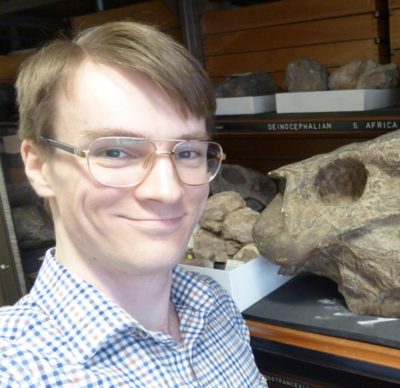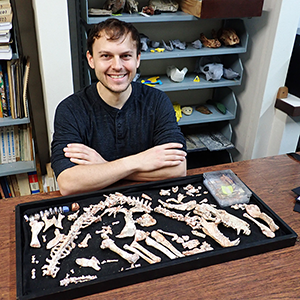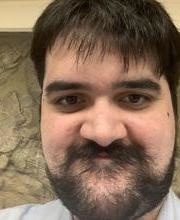| ____________________________________________________________________________________________________________________________________________ | |
| PI - Postdoctoral Researchers - Graduate Students - Undergraduate Researchers - Lab Administrator - Alumni | |
|
|
Stephanie E Pierce
Professor of Organismic and Evolutionary Biology
|
| ____________________________________________________________________________________________________________________________________________ | |
| PI - Postdoctoral Researchers - Graduate Students - Undergraduate Researchers - Lab Administrator - Alumni | |
Postdoctoral Researchers |
|
|
|
Peter BishopPostdoctoral FellowOriginally from Australia, Peter has had a lifelong passion for palaeontology, geology and mathematics. He gained a BAppSc (Hons) in Geosciences from the Queensland University of Technology in 2012, completed his PhD in Evolutionary Biomechanics from Griffith University in 2017, and subsequently held post-doctoral research positions at Griffith University, the University of the Sunshine Coast and the Royal Veterinary College. Over this time he has studied many extinct animals including freshwater crustaceans, fish, stem tetrapods, lizards, early archosaurs and dinosaurs (avian and non-avian). Peter is particularly interested in integrating biomechanics with data from fossils and modern animals, using a rigorous, physics-based approach to examine the adaptive significance of evolutionary changes in the vertebrate skeleton. In his current role, his research focuses on the sprawling-to-erect postural transition that took place in synapsids on the line to mammals, where he is using biomechanical modelling and simulation to understand the anatomical and physical factors that influenced and constrained this transition. Since 2007, Peter has also been part of the Geosciences Program of the Queensland Museum, Brisbane, first as a student volunteer and more recently as an Honorary Research Fellow. Email: pbishop@fas.harvard.edu Select Publications:
|
|
|
Robert BrocklehurstPostdoctoral FellowRob is a biomechanist, morphologist and evolutionary biologist, whose broad research interests revolve around the evolution of form and function in vertebrates. Rob was an undergraduate at the University of Cambridge, before gaining a master’s degree in palaeobiology at the University of Bristol. From there, he moved “up north” to the University of Manchester, where he received his PhD. His PhD thesis focused on the mechanics of ventilation in archosaurs (birds, crocodilians and dinosaurs), and combined a range of experimental and computational approaches. Rob joined the Pierce lab to examine the evolution of the mammalian forelimb, and the morphological and functional transitions which occurred during the evolution of Synapsids. Rob’s focus will be on creating musculoskeletal models of the forelimb of extinct and extant taxa, to test changes in muscle function and joint range of motion. However, this project, in collaboration with Ken Angielczyk (Field Museum of Natural History, Chicago), will ultimately combine the digital models with geometric morphometrics and both in vivo & ex vivo experimental data to test the functional and evolutionary implications of anatomical transformations in the mammalian forelimb. Email: rbrocklehurst@fas.harvard.edu Select Publications:
|
|
|
Tiago SimõesAlexander Agassiz Postdoctoral FellowTiago started his career in his home city (Rio de Janeiro, Brazil), where he obtained his BSc and MSc in Biological Sciences-Zoology at the Federal University of Rio de Janeiro, and began developing research on fossil reptiles at the National Museum of Brazil. He subsequently moved to Canada to pursue his PhD with Dr. Michael Caldwell at the University of Alberta, where he expanded his expertise on the evolution of lizards and snakes. Tiago's research interests include combining data from living and extinct species, as well as morphological and molecular data, to investigate deep time problems in reptile evolution. In recent years, he has revised previous phylogenetic and biogeographic hypotheses into the early evolution of lizards in South America and used high resolution µCT scans of modern lizards to assess the adaptive role of the temporal region of the lizard skull. Recently, he published the largest dataset ever assembled to assess broad-scale reptile relationships, finding the first ever agreement between morphological and molecular hypotheses on the early evolution of lizards. Further, he demonstrated that the major reptile lineages first evolved prior to the greatest mass extinction in the history of complex life— the Permian-Triassic Mass extinction. Currently, Tiago is investigating the impact of the Permian-Triassic Mass extinction on long-term evolutionary patterns in reptiles with Dr. Stephanie Pierce in the Museum of Comparative Zoology, Harvard University. Email: tsimoes@fas.harvard.edu Select Publications:
|
| ____________________________________________________________________________________________________________________________________________ | |
| PI - Postdoctoral Researchers - Graduate Students - Undergraduate Researchers - Lab Administrator - Alumni | |
Graduate Students |
|
|
|
Catie StrongCatie completed her B.Sc. and M.Sc. at the University of Alberta, with her Master’s research (supervised by Dr Michael Caldwell) focussing on skull evolution in burrowing snakes. She is interested in using quantitative techniques to explore the interplay between morphology, function, and macroevolution, particularly regarding how various components of the skeleton evolve during the conquest of land by early tetrapods. Email: crstrong@g.harvard.edu Select Publications:
|
|
|
Mark WrightMark was a Master's student in the Erasmus Mundus Master Program in Evolutionary Biology (MEME), then a Research Assistant in the Pierce lab, and now a PhD candidate. He is interested in the evolution of morphological traits and connecting morphology to function. He is currently investigating the functional consequences of transitional forms during early mammalian evolution, focusing on the locomotory shift from sprawling to parasagittal gaits. Email: markwright@g.harvard.edu
|

|
Tina KuangTina completed her BSc in Integrative Biology at UC Berkeley. During her time at Berkeley, she studied Fox squirrel jumping and landing biomechanics and worked on bio-inspired robotics in Prof. Robert Full’s Lab. She also worked in Prof. Jack Tseng’s lab where she developed a strong interest in functional morphology. Tina joined the Pierce Lab to explore the origin of arboreality in mammals. Taking advantage of the diverse locomotor groups in the Sciuridae family, she is combining an experimental and quantitative approach to elucidate variations in ankle bone morphology and joint range of motion. A key aspect of her research is the use of XROMM to visualize the osteological mechanisms enabling hindfoot reversal in highly arboreal animals. Her overarching goal is to uncover the morphological and biomechanical factors that influenced the shift from ground to tree habitats across metatherian and eutherian orders. Utilizing the XROMM data, she is interested in eventually developing musculoskeletal models that depict characteristic arboreal movements. Email: dkuang@g.harvard.edu |
|
|
Eloise HuntEloise is an evolutionary morphologist who is broadly interested in the evolution of form and function. Eloise completed her BSc at Imperial College London before attaining her Palaeobiology master's degree at the University of Bristol. Following this, she began her PhD at the Natural History Museum London, supervised by Professor Anjali Goswami and Professor Joseph Tobias, funded by the NERC SSCP DTP. Eloise is using 3D imaging, high-density geometric morphometrics, phylogenetic comparative methods, and evolutionary analyses to elucidate the complex intrinsic and extrinsic influences on avian skull morphology. Eloise is at the Pierce lab to investigate the interplay between avian skull shape variation and biomechanical performance. Email: eloisehunt@fas.harvard.edu
|

|
Letícia Rezende de Oliveira Letícia is a Brazilian PhD student with experience on vertebrate paleontology, focused on comparative anatomy, paleobiology, fossil preparation and digital reconstructions with emphasis on Triassic vertebrates. Her BCs and MCs degree were at the Federal University of Santa Maria at the Paleontological Support Research Center (CAPPA/UFSM). She is currently invested in ontogenetic, biomechanical and reconstruction techniques applied to Triassic Archosauromorpha. Email: lrdeoliveira@fas.harvard.edu |
| ____________________________________________________________________________________________________________________________________________ | |
| PI - Postdoctoral Researchers - Graduate Students - Undergraduate Researchers - Lab Administrator - Alumni | |
Undergraduate Researchers |
|
|
|
|
| ____________________________________________________________________________________________________________________________________________ | |
| PI - Postdoctoral Researchers - Graduate Students - Undergraduate Researchers - Lab Staff - Alumni | |
Lab Staff |
|
|
|
Tracy BarbaroLab AdministratorEmail: tbarbaro@oeb.harvard.edu
|
|
|
|
|
|
Robert HigginsResearch Assistantrobert_higgins@fas.harvard.edu
|
|
|
|
Copyright © 2024 The President and Fellows of Harvard College | Accessibility | Digital Accessibility | Report Copyright Infringement









